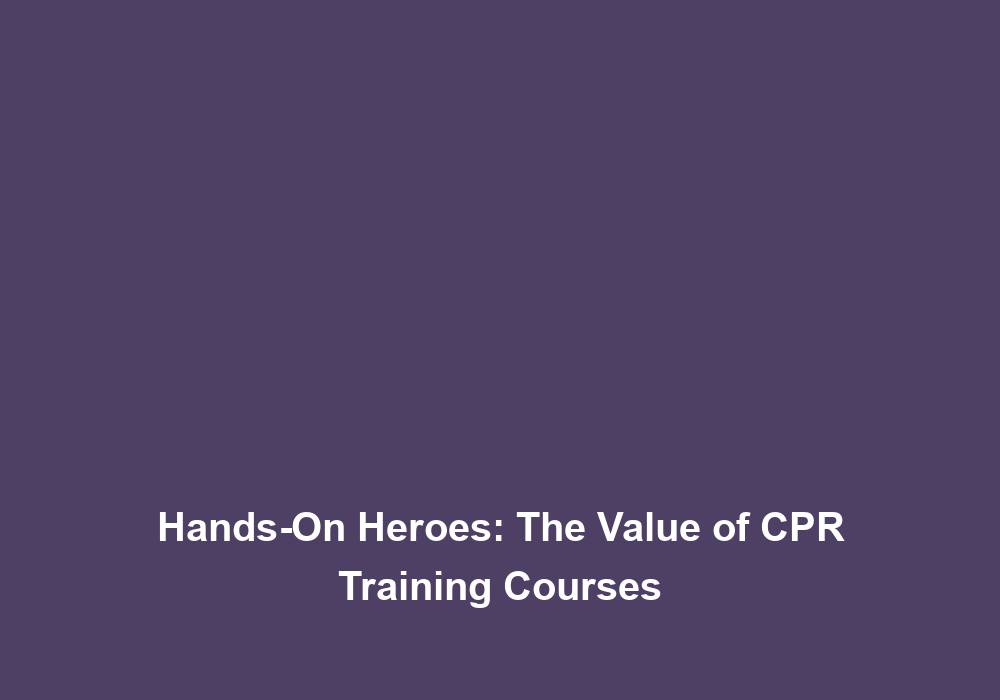Hands-On Heroes: The Value of CPR Training Courses
Cardiopulmonary resuscitation (CPR) is a life-saving technique that can be performed by anyone during emergency situations. With the ability to effectively deliver CPR, individuals become hands-on heroes who can make a significant difference in saving lives. CPR training courses are designed to equip individuals with the necessary skills and knowledge to respond promptly and confidently in critical situations. In this article, we will explore the immense value of CPR training courses and the benefits they offer.
Importance of CPR Training
-
Saving Lives: CPR is a crucial skill that can significantly increase the chances of survival for someone experiencing cardiac arrest. By performing CPR correctly and promptly, the flow of oxygenated blood to the vital organs is maintained until professional medical help arrives. CPR training empowers individuals to provide immediate assistance, potentially saving lives within those critical minutes.
- Performing CPR correctly involves understanding the proper hand placement and technique for chest compressions. This ensures that the compressions are deep enough to effectively circulate blood throughout the body.
- Prompt CPR can also prevent the development of irreversible brain damage by maintaining oxygen supply to the brain.
- By enrolling in CPR training courses, individuals gain the knowledge and skills needed to recognize the signs of cardiac arrest and provide timely intervention, increasing the likelihood of a successful outcome.
-
Rapid Response: During an emergency, every second counts. CPR training courses emphasize the importance of quick action. By enrolling in a CPR training course, individuals learn to recognize the signs of cardiac arrest and respond promptly, without wasting precious time. Rapid response can prevent brain damage and other serious consequences.
- CPR training teaches individuals to identify signs of cardiac arrest, such as sudden loss of responsiveness, absence of breathing, or abnormal breathing patterns. This allows for immediate recognition of the emergency.
- Prompt initiation of CPR helps to maintain blood circulation and deliver oxygen to the vital organs until advanced medical care is available.
- Quick action can significantly increase the likelihood of a positive outcome and improve the chances of survival for the victim.
-
Confidence and Preparedness: CPR training instills confidence in individuals, allowing them to act swiftly and confidently during emergencies. With proper training, individuals are better prepared to handle stressful situations, ensuring their actions are effective and potentially life-saving.
- CPR training equips individuals with the knowledge and skills necessary to perform CPR correctly. This knowledge instills confidence, as individuals understand the importance of their actions and the potential impact they can have.
- Through hands-on practice, individuals become familiar with the techniques and gain the necessary muscle memory to perform CPR effectively even under stressful circumstances.
- The confidence gained from CPR training enables individuals to take immediate action, potentially saving lives and minimizing the impact of cardiac arrest.
-
Public Safety: By increasing the number of individuals trained in CPR, overall public safety is enhanced. Imagine the positive impact if more people were equipped to administer CPR to victims in need. By spreading awareness and knowledge, CPR training courses contribute to building safer communities.
- By training a larger number of individuals in CPR, there is a higher likelihood that someone trained will be present during an emergency situation.
- Increased CPR-trained individuals in the community create a network of potential first responders, ready to provide life-saving interventions when needed.
- CPR training courses also raise awareness about the importance of CPR and encourage individuals to take proactive steps in ensuring public safety.
Components of CPR Training Courses
-
Cardiopulmonary Resuscitation (CPR) Techniques: CPR training courses focus on teaching participants the correct techniques for delivering compressions and rescue breaths. Participants learn how to perform chest compressions, ensuring proper depth and rate to maintain blood circulation. They also learn the correct method of providing rescue breaths to ensure adequate oxygenation.
- CPR training covers the importance of proper hand placement and the correct compression technique to ensure effective chest compressions.
- Participants learn about the recommended compression depth and rate, as well as the proper release and recoil technique to optimize blood flow.
- The training also emphasizes the importance of delivering rescue breaths effectively, ensuring adequate oxygen supply to the victim.
-
Automated External Defibrillator (AED) Training: AEDs are portable devices that deliver an electric shock to restore normal heart rhythm in individuals experiencing sudden cardiac arrest. CPR training courses often include instruction on the proper use of AEDs. Participants learn how to identify when an AED is necessary and how to safely operate the device.
- CPR training courses educate participants on the role of AEDs in cardiac arrest situations and emphasize the importance of their prompt use alongside CPR.
- Participants learn how to recognize when an AED is needed, such as when a victim is unresponsive and not breathing normally.
- The training covers the step-by-step process of operating an AED, including proper pad placement, analyzing the heart rhythm, and delivering a shock if necessary.
-
Recognition of Cardiac Arrest: Early recognition of cardiac arrest is crucial for initiating CPR promptly. CPR training courses teach participants how to identify the signs of cardiac arrest, such as sudden loss of responsiveness and abnormal breathing patterns. By learning these recognition skills, individuals can quickly assess the situation and determine whether CPR is required.
- CPR training emphasizes the importance of promptly recognizing cardiac arrest, as immediate intervention significantly improves the chances of survival.
- Participants learn to identify signs of cardiac arrest, such as the absence of breathing or abnormal breathing patterns, and the importance of activating the emergency medical system as soon as possible.
- Through training scenarios and case studies, individuals develop the skills to assess the situation and make informed decisions about initiating CPR.
-
Hands-On Practice: Hands-on practice is an integral part of CPR training courses. Participants have the opportunity to practice CPR techniques on mannequins, simulating real-life scenarios. This hands-on practice helps build muscle memory and enhances participants’ ability to perform CPR effectively under stressful situations.
- Hands-on practice allows participants to apply the knowledge they have gained and develop the necessary skills to perform CPR confidently.
- By practicing on mannequins, participants become familiar with the correct hand placement, compression technique, and rescue breath delivery, ensuring they can perform these actions correctly in a real emergency.
- Repetitive practice helps build muscle memory, enabling individuals to respond effectively and efficiently during high-stress situations.
Benefits of CPR Training Courses
-
Increased Survival Rates: Studies have consistently shown that prompt CPR significantly improves survival rates for individuals experiencing cardiac arrest. By enrolling in CPR training courses, individuals contribute to increasing the number of potential lifesavers in their communities, ultimately increasing the chances of survival for victims.
- Prompt initiation of CPR increases the chances of maintaining blood circulation and oxygenation, which are critical for the survival of someone experiencing cardiac arrest.
- By training more individuals in CPR, the likelihood of having someone nearby who can provide immediate assistance and initiate CPR increases, leading to improved survival rates.
- Communities with a higher percentage of CPR-trained individuals have been shown to have higher survival rates for cardiac arrest.
-
Empowerment: CPR training empowers individuals by equipping them with the knowledge and skills necessary to save lives. Being able to respond effectively during emergencies gives individuals a sense of control and purpose, fostering a culture of community resilience and support.
- CPR training enables individuals to take an active role in saving lives, providing them with a sense of empowerment and fulfillment.
- By being trained in CPR, individuals become part of a community of potential lifesavers, creating a supportive network that is prepared to respond to emergencies.
- The ability to make a difference in life-threatening situations fosters a sense of purpose and strengthens the overall resilience of the community.
-
Employment Opportunities: CPR certification is often required or preferred for various professions, such as healthcare providers, lifeguards, and first responders. By completing CPR training courses, individuals enhance their employability and open doors to a wide range of job opportunities.
- Many healthcare organizations and institutions require CPR certification as a prerequisite for employment. By completing CPR training, individuals increase their chances of being hired in these fields.
- Lifeguards and first responders are often required to have CPR certification to ensure they can respond effectively in emergency situations.
- CPR training can also enhance the resume and skillset of individuals in various industries, showcasing their dedication to safety and preparedness.
-
Peace of Mind: Knowing how to perform CPR provides individuals with a sense of security and peace of mind. Whether at home, work, or in public spaces, the ability to respond confidently during emergencies helps alleviate anxiety and fear, allowing individuals to take immediate action when it matters most.
- CPR training equips individuals with the knowledge and skills to handle emergency situations, reducing the feeling of helplessness during critical moments.
- By knowing how to perform CPR, individuals can act confidently and efficiently, minimizing the stress and anxiety associated with emergency situations.
- The peace of mind that comes with CPR training allows individuals to be proactive in ensuring the safety and well-being of their loved ones and the community as a whole.
In conclusion, CPR training courses are invaluable for anyone interested in making a difference during life-threatening situations. By empowering individuals with the knowledge and skills necessary to perform CPR, these courses create a community of hands-on heroes who can save lives. The importance of rapid response, confidence, and preparedness cannot be overstated when it comes to cardiac arrest. Enrolling in a CPR training course is not only a personal investment but also a contribution to the safety and well-being of the community. Become a hands-on hero today by embarking on the journey of CPR training.







